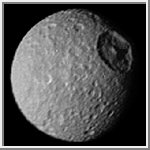
Tomorrow is St. Valentine's Day, set aside to celebrate romantic love. Saturn (understandably) does not much figure in love poetry, but at least one source brings the festival of Saturn and the festival of St. Valentine relatively close in time (this year anyway): According to Wikipedia, the Roman festival of Saturn was precedessor to carnival (MardiGras).
Now that we have reached Winter's mid-point and can't but look forward to Spring, here is a poem of love that reveals Saturn gamboling in April:
From you have I been absent in the spring,Here a description of the photo in Space.com:
When proud-pied April, dress'd in all his trim,
Hath put a spirit of youth in everything,
That heavy Saturn laugh'd and leap'd with him.
Yet nor the lays of birds, nor the sweet smell
Of different flowers in odour and in hue,
Could make me any summer's story tell,
Or from their proud lap pluck them where they grew;
Nor did I wonder at the Lily's white,
Nor praise the deep vermillion in the Rose;
They were but sweet, but figures of delight,
Drawn after you, you pattern of all those.
...Yet seem'd it Winter still, and, you away,
...As with your shadow I with these did play.
Sonnet 98, "From You I Have Been Absent," by William Shakespeare
Blue and Moon: Mimas Revisited
Saturn's moon Mimas drifts along in its orbit against the azure backdrop of the planet's northern latitudes in this true color view. The long, dark lines on the atmosphere are shadows cast by the planet’s rings.
Saturn’s northern hemisphere is presently relatively cloud-free and rays of sunlight take a long path through the atmosphere. This results in sunlight being scattered at shorter (bluer) wavelengths, thus giving the northernmost latitudes their bluish appearance at visible wavelengths.
At bottom, craters on icy Mimas (398 kilometers, 247 miles across) give the moon a dimpled appearance. (Image Credit: NASA/JPL/Space Science Institute)
And here is an enlargement of Mimas:

Solarviews.com gives information about the Mimas's most distinctive feature: "The crater [named Herschel] is 130 kilometers (80 miles) wide, one-third the diameter of Mimas. Herschel is 10 kilometers (6 miles) deep, with a central mountain almost as high as Mount Everest on Earth." The overall appearance of Mimas, it's impressive crater, and, possibly, its mythological association, lead people to call it the "Death Star" of Star Wars fame.




No comments:
Post a Comment